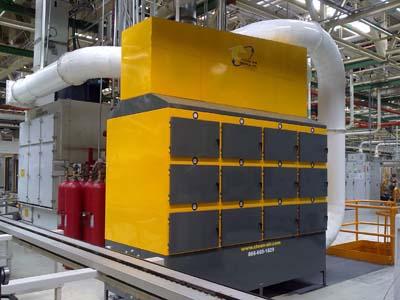
Clean Air America Inc. announces a new generation of industrial air cleaners, the Clean Air ScandMist. The ScandMist separates oil and emulsion mist and fumes created by modern machine tools and returns cleaned air directly to the production area.
"Various manufacturing operations, especially metal-cutting machining, a comprehensive term for turning, milling, grinding and boring, etc., generate oil mist and oil smoke that is hazardous to the work environment as well as the workers," said Jorgen Brahm, senior vice-president, Clean Air America. "Current filtration products can't keep up with the production demands of machines operating in a manufacturing environment. That's why we developed the ScandMist oil mist collectors."
Clean Air America licensed the ScandMist oil mist elimination technologies from Vokes Air in Sweden. Mist, smoke and harmful particles generated by metalworking machines are extracted at the source and cleaned by a three stage filtration process. The system efficiently separates oil fumes, oil mist, oily dust, and emulsion mist utilizing proprietary filters. Cleaned air is then returned directly to the workshop and exceeds international health and safety standards for maximum exposure limits to metalworking fluids, including standards by OSHA, NIOSH and HSE, etc. ScandMist utilizes Fiber Bed Principle filters that can operate continuously in the most extreme operating conditions.
Other features include:
Connection capability to several machine tools
Simple and low cost to install
Cleaned air can be returned directly to production area
Eliminates coolant mist (neat oil or emulsion)
Removes harmful particles including bacteria
No maintenance required, just read gauges
Main filter life can exceed 2 years; no filter cleaning required Speeds up production process
Simple and low cost to install Reduces power consumption
The ScandMist comes in a variety of models ranging from 400 to 50,000 cfm. In addition to these models, Clean Air also provides fully designed, turnkey oil mist removal systems tailored for each facility.
"Clean Air focuses on delivering 'green,' low cost, highly efficient solutions. Not only does ScandMist remove oil from the air, it allows you to collect the oil and re-use it within your operations," added Jorgen Brahm. "This saves the environment by keeping the oil out of landfills, lowers energy usage, and reduces costs."
Contact Details
Related Glossary Terms
- boring
boring
Enlarging a hole that already has been drilled or cored. Generally, it is an operation of truing the previously drilled hole with a single-point, lathe-type tool. Boring is essentially internal turning, in that usually a single-point cutting tool forms the internal shape. Some tools are available with two cutting edges to balance cutting forces.
- coolant
coolant
Fluid that reduces temperature buildup at the tool/workpiece interface during machining. Normally takes the form of a liquid such as soluble or chemical mixtures (semisynthetic, synthetic) but can be pressurized air or other gas. Because of water’s ability to absorb great quantities of heat, it is widely used as a coolant and vehicle for various cutting compounds, with the water-to-compound ratio varying with the machining task. See cutting fluid; semisynthetic cutting fluid; soluble-oil cutting fluid; synthetic cutting fluid.
- emulsion
emulsion
Suspension of one liquid in another, such as oil in water.
- gang cutting ( milling)
gang cutting ( milling)
Machining with several cutters mounted on a single arbor, generally for simultaneous cutting.
- grinding
grinding
Machining operation in which material is removed from the workpiece by a powered abrasive wheel, stone, belt, paste, sheet, compound, slurry, etc. Takes various forms: surface grinding (creates flat and/or squared surfaces); cylindrical grinding (for external cylindrical and tapered shapes, fillets, undercuts, etc.); centerless grinding; chamfering; thread and form grinding; tool and cutter grinding; offhand grinding; lapping and polishing (grinding with extremely fine grits to create ultrasmooth surfaces); honing; and disc grinding.
- metalworking
metalworking
Any manufacturing process in which metal is processed or machined such that the workpiece is given a new shape. Broadly defined, the term includes processes such as design and layout, heat-treating, material handling and inspection.
- milling
milling
Machining operation in which metal or other material is removed by applying power to a rotating cutter. In vertical milling, the cutting tool is mounted vertically on the spindle. In horizontal milling, the cutting tool is mounted horizontally, either directly on the spindle or on an arbor. Horizontal milling is further broken down into conventional milling, where the cutter rotates opposite the direction of feed, or “up” into the workpiece; and climb milling, where the cutter rotates in the direction of feed, or “down” into the workpiece. Milling operations include plane or surface milling, endmilling, facemilling, angle milling, form milling and profiling.
- turning
turning
Workpiece is held in a chuck, mounted on a face plate or secured between centers and rotated while a cutting tool, normally a single-point tool, is fed into it along its periphery or across its end or face. Takes the form of straight turning (cutting along the periphery of the workpiece); taper turning (creating a taper); step turning (turning different-size diameters on the same work); chamfering (beveling an edge or shoulder); facing (cutting on an end); turning threads (usually external but can be internal); roughing (high-volume metal removal); and finishing (final light cuts). Performed on lathes, turning centers, chucking machines, automatic screw machines and similar machines.
